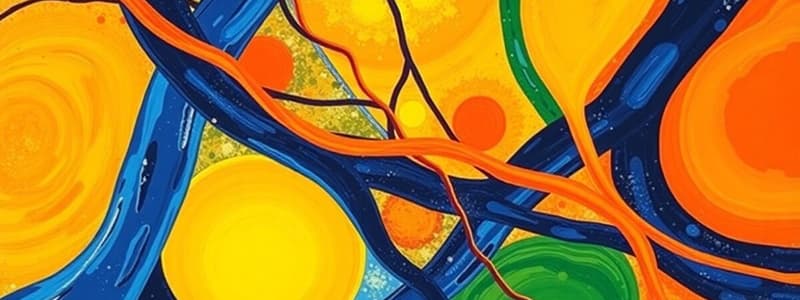Podcast
Questions and Answers
Which of the following describes the function of commissural fibers?
Which of the following describes the function of commissural fibers?
- Facilitate sensory information processing
- Link areas within the same cerebral hemisphere
- Connect corresponding areas between cerebral hemispheres (correct)
- Connect the hippocampus to the frontal lobe
What is the primary role of the corpus callosum?
What is the primary role of the corpus callosum?
- Link the left frontal lobe to the right occipital lobe
- Facilitate communication between the basal nuclei
- Provide structural support for the lateral ventricles
- Connect the cerebral cortices between the two hemispheres (correct)
Which fiber type primarily links areas in the same hemisphere?
Which fiber type primarily links areas in the same hemisphere?
- Transverse fibers
- Association fibers (correct)
- Commissural fibers
- Projection fibers
Identify the basal nucleus that is located most laterally compared to the others listed.
Identify the basal nucleus that is located most laterally compared to the others listed.
What is the main function of the anterior commissure?
What is the main function of the anterior commissure?
Which of the following is NOT a characteristic of the internal capsule?
Which of the following is NOT a characteristic of the internal capsule?
The cingulum primarily connects which of the following?
The cingulum primarily connects which of the following?
Which structure forms the roof of the lateral ventricles?
Which structure forms the roof of the lateral ventricles?
What does the splenium primarily overhang?
What does the splenium primarily overhang?
What structure is embedded within the lamina terminalis?
What structure is embedded within the lamina terminalis?
Which commissure connects the left and right hippocampus?
Which commissure connects the left and right hippocampus?
Which structure forms the outermost part of the lentiform nucleus?
Which structure forms the outermost part of the lentiform nucleus?
What is the main function of projection fibers?
What is the main function of projection fibers?
Which of the following correctly states a part of the lentiform nucleus?
Which of the following correctly states a part of the lentiform nucleus?
What is the role of the habenular commissure?
What is the role of the habenular commissure?
Which structure is located lateral to the thalamus?
Which structure is located lateral to the thalamus?
What type of fibers connect different lobes in the brain?
What type of fibers connect different lobes in the brain?
Which structure is known as the largest commissural fiber in the brain?
Which structure is known as the largest commissural fiber in the brain?
Which basal nucleus is located anterioinferiorly in the brain?
Which basal nucleus is located anterioinferiorly in the brain?
Which association fiber connects Broca’s area to the temporal lobe?
Which association fiber connects Broca’s area to the temporal lobe?
What is the primary function of projection fibers?
What is the primary function of projection fibers?
Which commissural structure is located at the posterior aspect of the brain?
Which commissural structure is located at the posterior aspect of the brain?
What is the role of the cingulum in the brain?
What is the role of the cingulum in the brain?
Which structure forms the most anterior part of the corpus callosum?
Which structure forms the most anterior part of the corpus callosum?
What are the posterior extensions of the splenium known as?
What are the posterior extensions of the splenium known as?
Which structure connects the amygdala and temporal lobes?
Which structure connects the amygdala and temporal lobes?
Where is the subthalamic nucleus primarily located?
Where is the subthalamic nucleus primarily located?
Which part of the lentiform nucleus is located medially?
Which part of the lentiform nucleus is located medially?
What fibers are responsible for linking the cerebral cortex to lower levels of the brain and spinal cord?
What fibers are responsible for linking the cerebral cortex to lower levels of the brain and spinal cord?
What separates the putamen from the globus pallidus within the lentiform nucleus?
What separates the putamen from the globus pallidus within the lentiform nucleus?
What connects the left and right hippocampus?
What connects the left and right hippocampus?
Which structure is located anterior to the pineal gland?
Which structure is located anterior to the pineal gland?
Flashcards
Association Fibres
Association Fibres
Connect areas within the same cerebral hemisphere.
Short Association Fibres
Short Association Fibres
Connect adjacent gyri within a cerebral hemisphere.
Long Association Fibres
Long Association Fibres
Connect different lobes within a cerebral hemisphere.
Uncinate Fasciculus
Uncinate Fasciculus
Signup and view all the flashcards
Cingulum
Cingulum
Signup and view all the flashcards
Superior Longitudinal Fasciculus
Superior Longitudinal Fasciculus
Signup and view all the flashcards
Inferior Longitudinal Fasciculus
Inferior Longitudinal Fasciculus
Signup and view all the flashcards
Fronto-occipital Fasciculus
Fronto-occipital Fasciculus
Signup and view all the flashcards
Commissural Fibres
Commissural Fibres
Signup and view all the flashcards
Corpus Callosum
Corpus Callosum
Signup and view all the flashcards
Rostrum
Rostrum
Signup and view all the flashcards
Genu
Genu
Signup and view all the flashcards
Body (Trunk) of Corpus Callosum
Body (Trunk) of Corpus Callosum
Signup and view all the flashcards
Splenium
Splenium
Signup and view all the flashcards
Minor Forceps
Minor Forceps
Signup and view all the flashcards
Major Forceps
Major Forceps
Signup and view all the flashcards
Tapetum
Tapetum
Signup and view all the flashcards
Anterior Commissure
Anterior Commissure
Signup and view all the flashcards
Posterior Commissure
Posterior Commissure
Signup and view all the flashcards
Habenular Commissure
Habenular Commissure
Signup and view all the flashcards
Commissure of the Fornix
Commissure of the Fornix
Signup and view all the flashcards
Projection Fibres
Projection Fibres
Signup and view all the flashcards
Internal Capsule
Internal Capsule
Signup and view all the flashcards
Anterior Limb of Internal Capsule
Anterior Limb of Internal Capsule
Signup and view all the flashcards
Genu of Internal Capsule
Genu of Internal Capsule
Signup and view all the flashcards
Posterior Limb of Internal Capsule
Posterior Limb of Internal Capsule
Signup and view all the flashcards
Lentiform Nucleus
Lentiform Nucleus
Signup and view all the flashcards
Basal Ganglia
Basal Ganglia
Signup and view all the flashcards
Putamen
Putamen
Signup and view all the flashcards
Lentiform Nucleus
Lentiform Nucleus
Signup and view all the flashcards
Study Notes
White Fibre Bundles
- Association Fibres
- Link areas within the same cerebral hemisphere
- Short Fibres: Connect adjacent gyri
- Long Fibres: Connect different lobes
- Uncinate Fasciculus: Connects Broca's area, orbital gyri and temporal lobe
- Cingulum: Connects rostrum to temporal lobe
- Superior Longitudinal Fasciculus: Connects frontal and occipital lobes
- Inferior Longitudinal Fasciculus: Connects occipital and temporal lobes
- Fronto-occipital Fasciculus: Connects frontal and occipital lobes, located lateral to the caudate nucleus and superior longitudinal fasciculus
- Commissural Fibres
- Course across the midline
- Link corresponding areas between cerebral hemispheres
- Examples
- Corpus Callosum: Links cerebral cortices between two hemispheres, forms the roof of the lateral ventricles
- Rostrum: Anterior inferior part
- Genu: Most anterior part
- Body (Trunk): Arches posteriorly, convex superiorly
- Splenium: Most posterior part, overhangs the pineal gland
- Minor Forceps: Anterior extensions of the genu, connecting medial and lateral front lobe surfaces
- Major Forceps: Posterior extensions of the splenium, courses between the occipital lobes
- Tapetum: Lateral projections of the splenium and body
- Anterior Commissure: Embedded within the lamina terminalis, anterior border of the third ventricle, connects amygdala and temporal lobes, important for the olfactory pathway
- Posterior Commissure: Contains fibres from the thalamus and superior colliculus, important for language processing pathways
- Habenular Commissure: Located anterior to the pineal gland, connects the habenular nuclei
- Commissure of the Fornix: Connects the left and right hippocampus, fibres terminate in the thalamus and mammillary bodies
- Corpus Callosum: Links cerebral cortices between two hemispheres, forms the roof of the lateral ventricles
- Projection Fibres
- Link cerebral cortex to lower levels of the brain and spinal cord
- Internal Capsule:
- Anterior Limb: Lateral to caudate nucleus
- Genu: Between caudate nucleus and thalamus
- Posterior Limb: Lateral to the thalamus
- Lentiform Nucleus: Lateral to the internal capsule
Basal Nuclei (Basal Ganglia)
- Collection of gray matter structures responsible for posture and voluntary movements
- Nuclei connect to the thalamus, cortex, and neighbouring basal nuclei
- Nuclei in each Cerebral Hemisphere:
- Putamen: Outermost part of the lentiform nucleus, separated from the globus pallidus via the lateral medullary lamina, located where the diencephalon and telencephalon fuse
- Caudate Nucleus
- Nucleus Accumbens
- Globus Pallidus: Divided into medial (GPi) and lateral (GPe) parts, separated by the medial medullary lamina
- Other Sub-cortical Nuclei:
- Subthalamic Nucleus: Located in the diencephalon
- Substantia Nigra: Located in the rostral midbrain
- Lentiform Nucleus: Collective name for the globus pallidus and putamen, wedge-like shape (horizontal section)
White Matter Tracts
-
Association fibres connect areas within the same cerebral hemisphere.
- Short fibres connect adjacent gyri, possibly within the same lobe.
- Long fibres connect different lobes.
- Uncinate fasciculus connects Broca's area, orbital gyri, and the temporal lobe.
- Cingulum connects the rostrum to the temporal lobe.
- Superior longitudinal fasciculus connects frontal and occipital lobes.
- Inferior longitudinal fasciculus connects occipital and temporal lobes.
- Fronto-occipital fasciculus connects frontal and occipital lobes.
- It lies lateral to the caudate nucleus and superior longitudinal fasciculus.
-
Commissural fibres cross the midline, connecting the cerebral cortex of both hemispheres.
- Corpus callosum links the cerebral cortices of both hemispheres.
- It forms the roof of the lateral ventricles.
- It has a rostrum, genu, body (trunk), and splenium.
- The rostrum is anterioinferior, genu is the most anterior part, the body arcs posteriorly, and the splenium is the most posterior part.
- The splenium overhangs the pineal gland.
- The corpus callosum has minor forceps (anterior extensions of the genu connecting medial and lateral frontal lobe surfaces) and major forceps (posterior extensions of the splenium connecting occipital lobes).
- The tapetum is lateral projections of the splenium and body.
- Anterior and posterior commissure connect parts of the brain.
- The anterior commissure connects the amygdala and temporal lobes, forming the anterior border of the third ventricle. It's important for the olfactory pathway.
- The posterior commissure is important for language processing pathways.
- Habenular commissure connects habenular nuclei, located anterior to the pineal gland.
- Commissure of the fornix connects left and right hippocampi.
- Fibres of the fornix terminate in the thalamus and mammillary bodies.
- Corpus callosum links the cerebral cortices of both hemispheres.
-
Projection fibres link the cerebral cortex to lower levels of the brain and spinal cord.
- They are located in the internal capsule.
- Internal capsule is divided into:
- Anterior limb lies lateral to the caudate nucleus.
- Genu lies between the caudate nucleus and thalamus.
- Posterior limb lies lateral to the thalamus.
Basal Ganglia
-
Basal ganglia are collections of gray matter structures responsible for posture and voluntary movement.
- They connect with the thalamus, cortex, and neighboring basal nuclei.
- Each cerebral hemisphere has a putamen, caudate, nucleus accumbens, and globus pallidus.
- Collectively, these structures are referred to as the corpus striatum.
- The subthalamic nucleus lies in the diencephalon.
- The substantia nigra lies in the rostral midbrain.
-
Lentiform nucleus:
- A collective term for the globus pallidus and putamen.
- It has a wedge-like shape in a horizontal section.
-
Putamen:
- Outermost part of the lentiform nucleus.
- Separated from the globus pallidus by the lateral medullary lamina.
- It is located at the fusion of the diencephalon and telencephalon.
-
Globus pallidus:
- Divided into medial (GPi) and lateral (GPe) parts.
- They are separated by the medial medullary lamina.
Studying That Suits You
Use AI to generate personalized quizzes and flashcards to suit your learning preferences.





